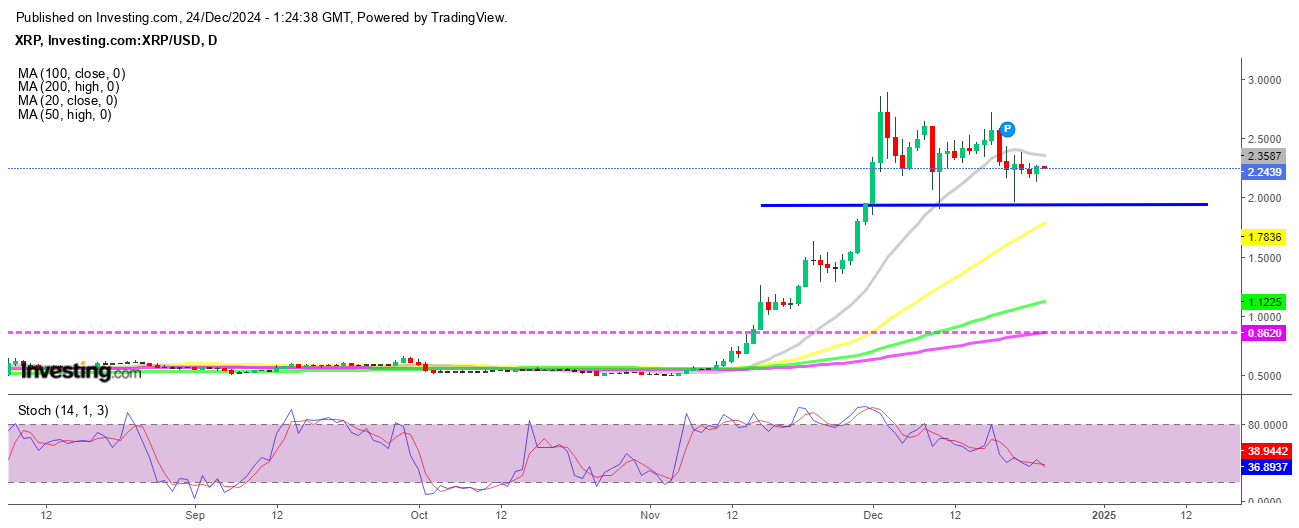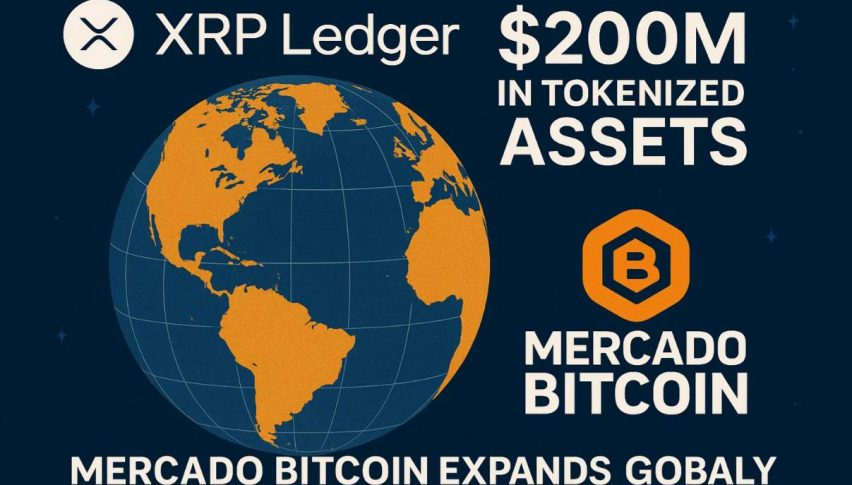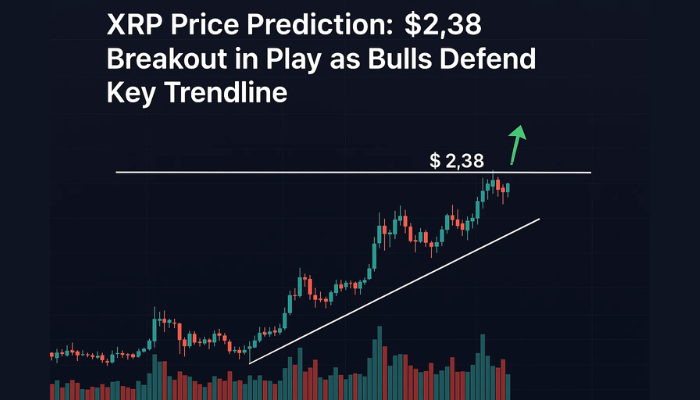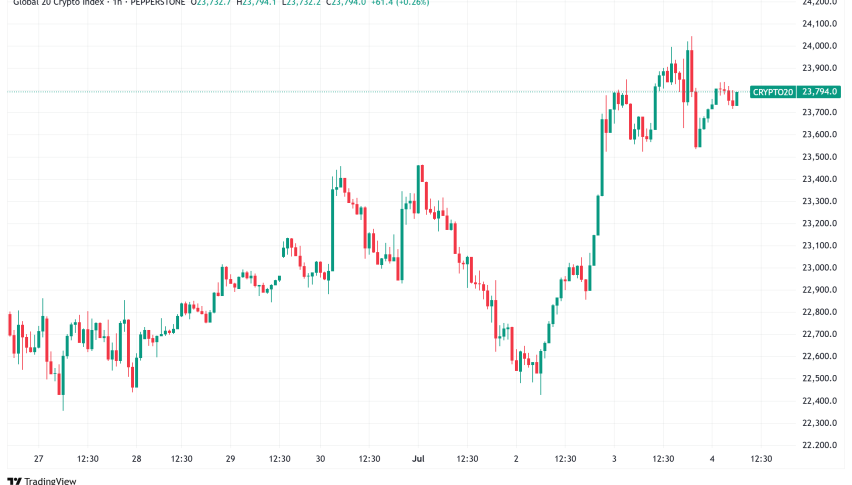Ripple (XRP) coin saw some positive developments in 2024, progressing its case against the SEC which was a milestone for the crypto market, and increasing several times in value. That was a relief for the market, and considered a green light toward entering in all aspects of the mainstream financial world. Ripple saw a massive surge of more than 500% in the next few weeks, pulling the whole crypto market up, and opening the door for further gains in 2025, perhaps reaching $10 by the end of the year.
Ripple Chart Daily – The Support at $2 Is A Good Place/ to Buy XRP
On the daily chart above we can see that during November 2024 and in Early December the bullish momentum in the XRP was quite strong due to the court’s decision for a deadline regarding the SEC legal case on January 2025, with moving averages unable to catch up with the price. However, the 20 SMA (gray) caught up eventually as the price started to consolidate above $2, piercing below this level twice, but finding buyers pretty quickly, which shows that buyers are active around the $1.90 area and this is the level where they draw the line in the sand, so Ripple trades have too keep this level in mind as a support zone where they can look to buy XRP during dips in 2025, first targeting the $2.70 high from December, and then $3 and even $5 in Q2 of 2025, considering the recent progress in Ripple Labs.
On December 17, 2024, Ripple Labs formally introduced Ripple Labs USD (RLUSD), a stablecoin backed by the US dollar, meant to be utilized as a means to store value from price volatility, thus expanding its offerings in the digital asset space, as explained in the following sections. This opens the door for further integration of Ripple products into the mainstream financial system in 2025 and the following years, which would increase the demand for the XRP coin. Adding here the legal victory against SEC, Ripple is off to a strong start in 2025, with the area around $2 acting as support.
Originally named OpenCoin, the company rebranded as Ripple in 2015 operating as a private company offering RippleX, a software suite designed for developers and businesses building applications on top of XRP. With 100 billion tokens issued at launch, XRP was pre-mined, in contrast to many other cryptocurrencies, while transactions close in less than four seconds, so Ripple’s network can process 1,500 transactions per second. Ripple Labs, a software company founded in 2012 as a solution to the inherent constraints of Bitcoin, is known for developing the open-source Ripple Protocol. This protocol includes the XRP Ledger and RippleNet, which provide cross-border payment solutions tailored for institutional use, such as banks, governments, financial institutions, and cryptocurrency exchanges.
Ripple Technical Analysis
Ripple token started as a penny coin, trading below $0.10 for several years until 2017, when it gave the first signs of a bullish move, after increasing several times in value above $0.10. The XRP consolidated around those levels until buyers had a second go in December, gaining around 3,000% and sending the price to $3.2970 by January 2018 during a major crypto surge.
However, the retreat was just as fast and XRP/USD retreated below $1 again, consolidating around $0.20 during 2018-2019. In November 2020 Ripple coin attempted the upside again, jumping to $0.80, but the lawsuit by the SEC scared the investors away and the rice fell back to $0.20. That didn’t last long and buyers returned as the crypto market went through another period of ”gold rush”, which sent the price to $1.98 by April 2021, increasing nearly ten fold in value.
XRP/USD Chart Monthly – The 2017 High Is Still to Be Broken
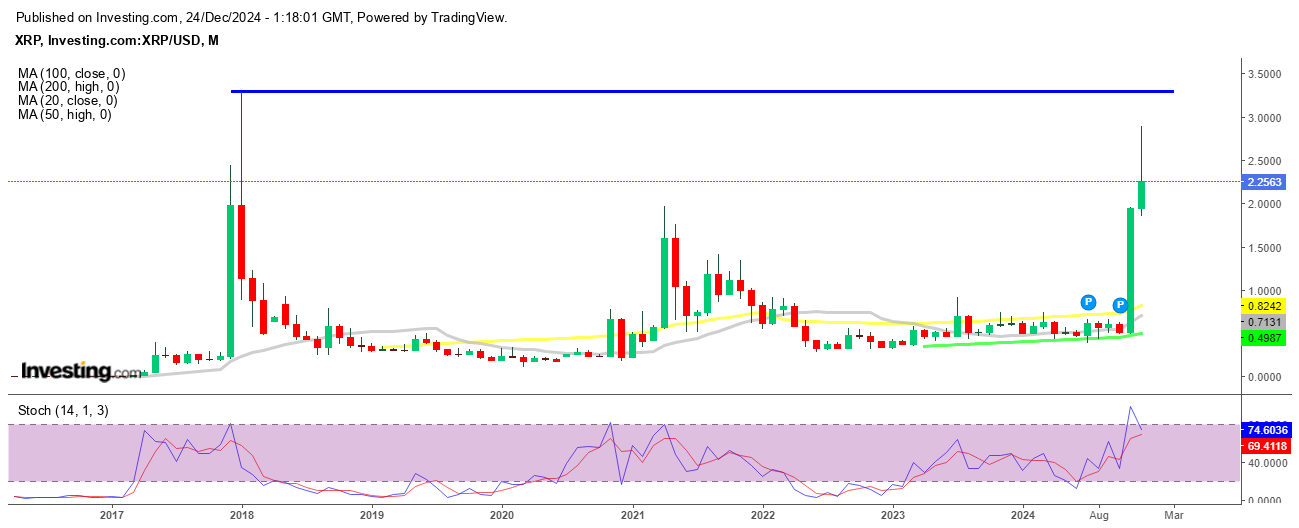
However, the gains couldn’t be sustained once again and another reversal took place, as the crypto rally faded, while the SEC lawsuit continued. However, the retreat was slower for XRP/USD this time and the decline also stalled higher than the previous range, at $0.30, which were positive signs for XRP holders. XRP consolidated between two moving averages on the monthly timeframe chart, with the 100 SMA (green) acting as support at the bottom and the 50 SMA (yellow) acting as resistance at the top.
There was a spike higher in July 2023 after some positive development regarding the legal case against Ripple Labs, but the case continued and the price retreated back within the range. XRP missed the surge during early 2024 in the crypto market, which was pessimistic for Ripple investors, but caught up somewhat in the second surge of 2024 toward the end of the year which sent Bitcoin above $100K. Although, while the crypto market surged after Donald Trump who is a crypto supporter won a second term as US president, XRP/USD surged after winning the legal case against the SEC. Ripple bounced off the 100 monthly SMA at $0.50 to $2.90.
Ripple’s Legal Battle with the SEC: A Pivotal Moment for Crypto Regulation
Ripple’s long-running legal issue continues to draw attention, as its outcome could significantly influence the regulatory framework for the crypto industry. Spanning over four years, the case has caused frustration within the XRP community due to numerous delays.
In August 2024, Ripple committed $125 million in an earlier settlement, resulting in a 30% surge in XRP, although the price remained range-bound. The SEC appealed the decision in October, but on November 1, 2024, the U.S. Court requested the SEC to submit its main appeal brief by January 15, 2025. Failure to meet this deadline would result in the appeal being dismissed, a development widely seen as a victory for Ripple and the broader crypto market. The lawsuit’s resolution, anticipated in 2025, is expected to remove significant regulatory hurdles, potentially opening the door for XRP-based ETFs and broader market adoption.
Leadership Change at the SEC: A Positive Signal for Crypto in 2025
The upcoming departure of SEC Chairman Gary Gensler on January 20, 2025, has sparked optimism within the crypto community. His successor, Paul Atkins, is known for his more relaxed stance on digital assets and has criticized the SEC’s enforcement-heavy culture. Atkins favors the establishment of clear regulations, which could lead to a friendlier environment for cryptocurrencies.
Market participants expect a policy shift this year under Atkins, with his leadership potentially fostering innovation and clarity in the sector. While legal certainty alone cannot determine the XRP market value, it addresses a critical concern. If regulatory barriers are lifted, XRP could find its way into traditional financial products by 2025, marking a significant milestone for the token and the broader crypto ecosystem.
Ripple’s RLUSD and Expanding Use Cases
Ripple’s RLUSD stablecoin, equivalent to the US dollar, launched on the Ethereum blockchain and XRP Ledger with full backing by USD reserves and short-term U.S. Treasury bonds. Designed for remittances, cross-border payments, and DeFi applications, RLUSD is overseen by the New York Department of Financial Services (NYDFS), ensuring its compliance and security.
Monica Long, president of Ripple, anticipates 2025 to be a breakthrough year for XRP ETFs, following the SEC’s approval of Ethereum and Bitcoin ETFs last year. With other firms already applying for spot XRP ETFs, she expects Ripple to secure approval soon. Demand for stablecoins like RLUSD is also set to grow, with plans for additional exchange listings and further updates on its availability expected soon.
Market Expansion and Grayscale’s XRP Trust
Singapore-based Independent Reserve recently listed RLUSD, integrating it into its OTC desk and order book. As of December 22, 2024, RLUSD is tradable on its platform, competing with Tether and USD Coin. Meanwhile, Grayscale’s XRP Trust, launched in September, has surged 300%, allowing investors to gain exposure to XRP without managing the asset directly. The trust’s success has fueled speculation that an XRP ETF could be approved in the near future, further advancing Ripple’s market position.
Upcoming Developments in the Ripple Ecosystem and XRP Price Prediction for 2025
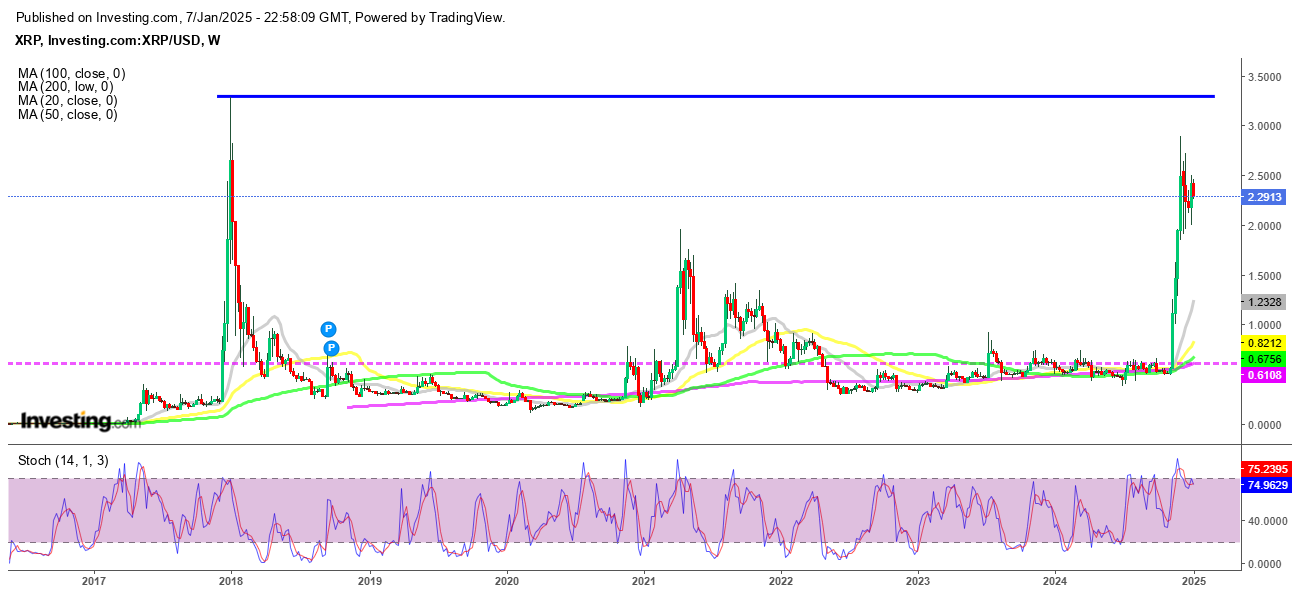
Ripple’s anticipated settlement with the SEC in January 2025 could be a turning point, potentially unlocking institutional investment and allowing Ripple to expand its influence in the financial sector. The company’s 2025 vision aims to position it as a leading provider of digital assets for global financial institutions, with a focus on driving innovation and adoption.
A key element of this strategy is RLUSD, designed to create a “comprehensive tokenization platform” and an “internet of value.” Ripple also plans to launch an Ethereum Virtual Machine (EVM) sidechain on XRPL to connect with over 50 blockchains, leveraging its decentralized exchange (DEX) capabilities for tokenizing complex assets. Besides that, monthly audits of RLUSD’s reserves will build trust, while enhanced on-ramp and off-ramp solutions will facilitate seamless transitions between crypto and fiat. These developments aim to solidify Ripple’s standing as a major player in the financial industry by 2025.
Other XRP Forecasts for 2025
- Growing Use in Cross-Border Payments: The increasing adoption of digital assets for cross-border payments positions XRP as a favored solution, driving demand and potentially boosting its price. XRP’s ongoing innovation and adoption suggest strong growth prospects within the evolving crypto ecosystem.
- Market Predictions:
- Techopedia: Projects an average price for XRP around $3, with a potential range between $1.50 and $4.50, depending on market conditions.
- CoinPedia: Highlights Ripple’s strategic partnerships and XRP’s expanding role in payment systems, forecasting potential highs of $3.40 to $3.80.
XRP Metrics Show Decent Growth in 2024
XRP demonstrated strength in December despite the Federal Reserve’s more cautious forecasts for 2025 tempering overall market sentiment. The XRP Mean Coin Age metric, which measures the average duration tokens remain in their current addresses, revealed that investors were largely holding rather than selling, unlike many other cryptocurrencies.
Dormant Circulation data further indicated accumulation, which supported XRP’s price above $2, even as Bitcoin fell below $100K. This confidence in XRP was driven by several anticipated developments, including the potential launch of an XRP ETF in 2025, Donald Trump’s presidency, and a more crypto-friendly SEC administration. XRP also saw a 220% surge in transaction volume during December, peaking at over 4 million daily, while new account activations exceeded 30,000 following positive Ripple-related news.
Data from CryptoQuant reveals that significant wallet transfers, often referred to as whale activity, have surged over the past month, reaching levels far beyond previous records. In December, large-scale investors moved substantial amounts of XRP, including a notable transaction valued at $222 million. Amid recent market turbulence, XRP has faced a retreat toward $2, however, since the downturn began in early December, whales have added 100 million XRP to their holdings. This accumulation highlights XRP’s resilience despite the sell-off, pointing to strong underlying demand that could potentially support a price recovery.
Conclusion: XRP’s Growth Potential in a Maturing Crypto Landscape
Ripple and its native token, XRP, are well-positioned to benefit from the evolution of the cryptocurrency industry and increasing institutional adoption. The strong start to 2025, highlighted by the RLUSD launch and a significant legal victory, has fueled ambitious predictions for XRP’s future. However, the XRP price now has to push the price above the 20 SMA, which will likely be broken by buyers, since XRP has shown resilience even with the crypto market retreating, with BTC falling close to $90K in late December. Besides that, the new US administration is crypto-friendly, which will help keep the sentiment positive in the cryptocurrency market, benefiting XRP which will likely reach the 2017-18 high at $3.30 and even break it on the way toward $5 and eventually $10 if the sentiment in the crypto market in 2025 remains similar to last year.

